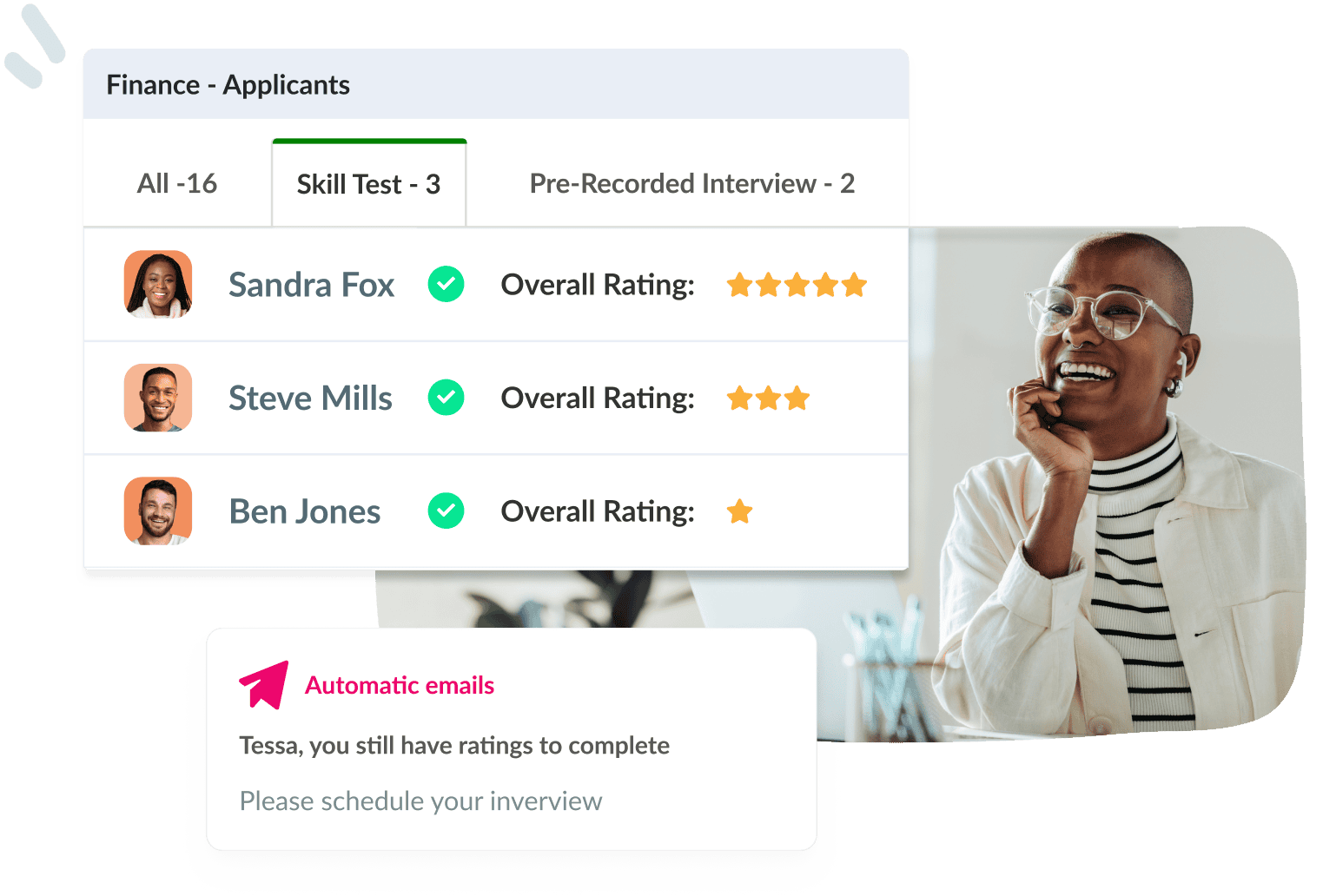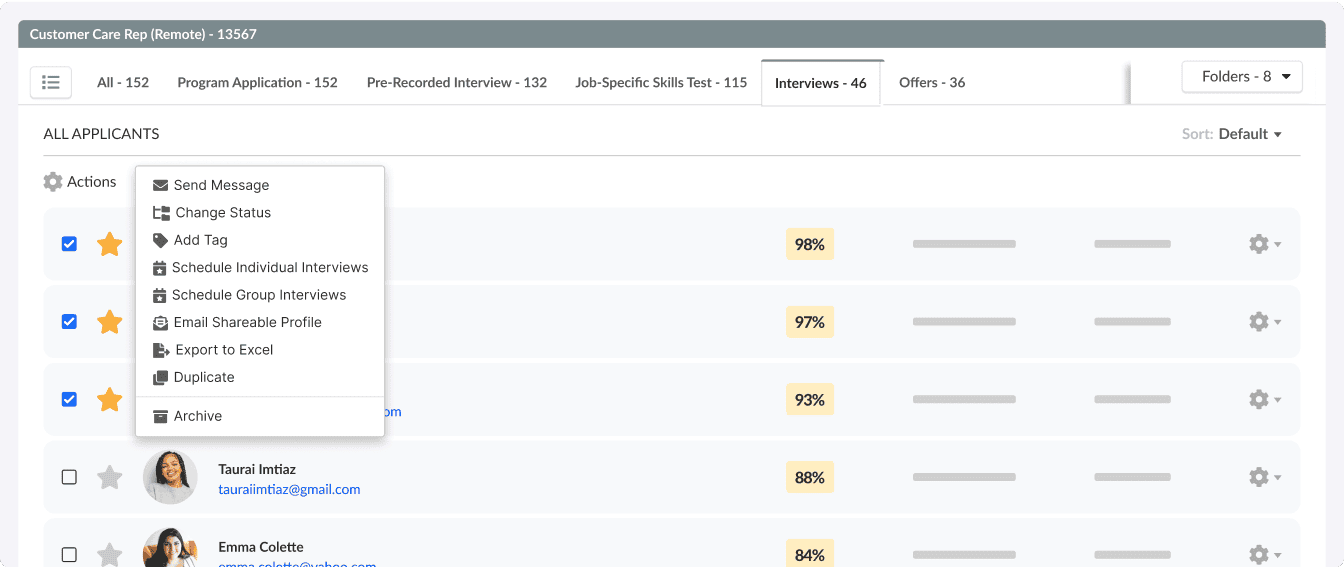
How To Conduct a Structured Interview
Learn how to conduct structured interviews effectively with our comprehensive guide.

TL;DR: How Do Applicant Tracking Systems Work?
Applicant tracking systems help employers by automating hiring tasks, from pre-screening applicants to reaching out about interviews. Most medium and large-sized organizations use one to speed up time-to-hire and reduce costs, but how does an ATS work? And what does it do?

The implementation of automated workflows and integrations digitize the hiring process, reducing the time-to-hire by streamlining administrative tasks such as internal coordination, posting job openings, and pre-screening applicants. It also keeps an up-to-date digital record of applicants, allowing hiring teams to track their progress in real-time.
An ATS can simplify the job requisition process by creating an automated workflow, with transparent notifications, to streamline a complex process. Hiring managers can create a job requisition, complete with the job description and approval workflow, by filling out a single form.

Most tracking systems allow employers to distribute new job openings to their careers page and external job boards. More sophisticated systems can measure the effectiveness of each channel and automate distribution with one-click functionality.
With a platform in place, HR teams can supplement the work of pre-screening applicants.
Knock-out questions:
Employers can add knock-out questions to application forms that determine if applicants meet their basic requirements (licenses, certifications, etc.). If an applicant responds “no”, the platform filters those applications out of the list of candidates to review. It can even send those applicants a notification that they were unsuccessful.
Qualification matching:
In addition to direct questions on the application form, the platform can work out who meets the job requirements by scanning the resume for specific keywords. The system will then score the candidate according to how closely the resume matches the job description.
Candidate pool creation:
As part of the scanning process, the platform will work to parse the resume based on aspects such as contact information, certifications, work history, etc., to create a “candidate profile” within the platform. The platform will group qualified applicant profiles together to help employers by creating a “pool” of shortlisted individuals to review.
Studies show up to 75% of qualified candidates can be rejected by an ATS because it cannot read the resume. Using an ATS-friendly resume will ensure you don’t get rejected based on formatting.
Platform automation will advance a candidate to the next hiring phase once they’ve completed an action. The system will also notify relevant hiring managers of the change in the candidate’s status.
For example, a candidate automatically moves to the interview stage after meeting a predetermined score on their skills assessment. The platform then notifies the candidate to choose an interview time and notifies the hiring manager and interview panel once the interview is booked.

Whether you have a formal HR department seeking stakeholder feedback, or a team of individuals coordinating on decisions, the decision-making process involves a lot of collaboration. These systems can help make decision-making easier by:
Sending automated reminders to team members who haven’t yet reviewed and evaluated applicants
Enabling the sharing of feedback and notes within the candidate profile
Aggregating a candidate’s interview scores (when using interview tool integration)
To help employers decide where to post their next role, or how to make improvements to their process, these systems provide reporting on aspects like sourcing ROI and time-to-hire broken down by each phase.
Creating an equitable experience begins with having the right hiring processes in place. Organizations can use an applicant tracking system to realize their ideal hiring processes by creating tailored workflows that drive DEI initiatives.

Automation can help facilitate the work involved in the final hiring stages. After the final decision, a hiring manager can draft an offer letter and send it for internal approval within the system, much like the initial requisition form.
The system can also send the letter to the candidate and store the trail of communications and document changes in a single location
How important is a good onboarding process? Studies have shown that a strong onboarding program can improve new hire retention by 82% and productivity by 70%
Only 12% of employees believe their company did a great job with their onboarding.
How does an ATS work for onboarding? Integrations come into play here as well. Most systems can plug in to an employer’s payroll or HRIS system. This helps employers get started on the onboarding process by transferring over all of the candidate information quickly and securely. The integration between platforms will automatically map the candidate information from the platform to the required fields in the payroll/HRIS system.
They can also help employers stay in touch with new hires before they start work with personalized communications. These may include welcome messages from the candidate’s new team or pertinent information about the organization.

Request new positions
Post open positions
Import applications
Store candidate information
Pre-screen applicants
Track applicants
Build candidate relationships
Enable team collaboration
Monitor performance
Onboard new hires
They help employers focus on getting to know qualified candidates rather than spending time on administrative tasks. In other words, they reduce time-to-hire and ensure better hiring decisions. They also facilitate greater collaboration between team members at all hiring stages.
Lastly, storing candidate information centrally reduces the risk of data loss or security when using multiple hiring tools or manual processes.
While they have many advantages, the nature of automated resume screening (or “parsing”) means that some qualified candidates may not make it through to the shortlist. It usually comes down to resume formatting, for example, images or tables that are difficult for the system to understand. A lack of exact keyword matches to the employer’s pre-determined qualifications can also play a part. Hiring managers can minimize this risk by including a wide range of keywords synonyms for experience and qualifications.
Key features include workflow automation around candidate advancement and tracking. During the initial hiring phases, it can help alleviate the work involved in posting and advertising positions with one-click job board postings and custom careers.
These systems help employers build strong relationships with applicants through automated communications throughout the hiring process. They also streamline interview scheduling and save unsuccessful candidate profiles for later, which helps create a candidate experience.
Modernize your hiring process with expert insights and advice.